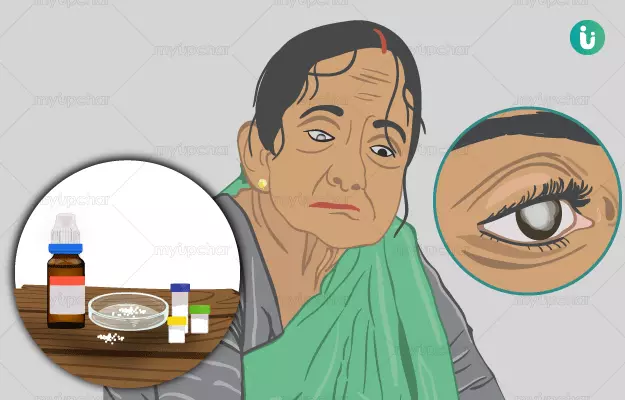- Cineraria Maritima
Common name: Dusty miller
Symptoms: This remedy is primarily indicated for the treatment of corneal conditions that reduce vision and lead to cataracts. It is also used to treat senile cataract seen in elderly and traumatic cataracts.
- Calcarea Fluorica
Common name: Fluoride of lime
Symptoms: This remedy is best suited for the treatment of varicose veins, goitre and malnourished bones, and it is very useful in treating cataract. It is also helpful in reducing the following symptoms:
- A hardened mass on the skin that might lead to pus formation
- Phlyctenular keratitis (inflammation of the cornea or conjunctiva with blister-like eruptions)
- Sparks and flickering in front of the eyes
- Conjunctivitis
- Spots on the cornea
- Pus formation in ears
- Brain fog
Symptoms become worse during weather changes and while taking rest. They become better while using warm applications and in the presence of heat.
- Euphrasia Officinalis
Common name: Eyebright
Symptoms: This remedy is suited for people who feel better when they are in open air. It is useful in reducing inflammation in the conjunctival membrane of eyes, especially when the inflammation causes profuse tearing from eyes. It is also useful in reducing the following symptoms:
- Inflammation in the mucous membranes of nose and eyes
- Excessive watering of eyes
- Headaches caused due to inflammation
- Profuse flow of tears with irritation
Symptoms are aggravated in the presence of warmth, southern winds, in the evening time and on staying indoors. They become better after consuming coffee and in the dark.
- Causticum
Common name: Hahnemann's tinctura acris sine kali
Symptoms: This remedy is suited for people who have lost weight due to a disease or due to excessive worrying. It helps reduce cataract that develops due to changes in the nervous system. It also reduces the following symptoms:
- Ptosis (drooping of the upper eyelid)
- Impaired vision
- Inflammation of eyelids
- Ulcers in eyes
- Dark spots in eyes
- Paralysis of eye muscles after being exposed to cold surroundings
- A cough that produces pain in hips
Symptoms become worse in cold and dry winds, cold weather and in clear weather. They become better in wet and warm weather and in damp areas.
- Silicea Terra
Common name: Silica.
Symptoms: Silicea Terra is best suited to people who feel chilly and cold and need plenty of warm clothing to maintain body heat. Their hands and feet become even colder during winters. This remedy is primarily useful in treating a stye and swelling of tear-producing (lacrimal) ducts. It also relieves the following symptoms:
- A sharp and dazzling pain due to exposure to light
- Unclear vision
- Letters running together while reading
- Abscess in the cornea after a traumatic injury
- Cataracts occurring in people who work in the office (enclosed environments)
- Sloughing or perforating ulcers in the cornea
- Iritis and iridochoroiditis (inflammation of the iris and choroid), with pus formation in the anterior chamber of the eye
- Opacity after a keratitis (inflammation in the clear tissue of the eye) infection in the eye
- Affected angles of the eye
Symptoms become worse in the morning and new moon, during menstruation, while lying down on the left side, after washing. Symptoms become better in humid or wet weather, in the summer, with warmth and after wrapping up the head.
- Sulphur
Common name: Brimstone
Symptoms: This herb is best suited for people who argue and worry constantly. It helps treat cataract by reducing dimness of vision and opacity in the cornea. This remedy also helps reduce the following symptoms:
- Pain in eyelids
- Pain caused due to dryness in eyes
- Cloudy sight while reading
- Profuse tearing
- White spots in eyes
- Trembling of eyes
- Night-blindness
- Aversion to light, especially sunlight
- Redness in iris due to inflammation
- Pain due to dried eyeballs
- Watery eyes
- Dryness of eyes
- A tickling, burning and itching sensation in eyes and eyelids
- Conium Maculatum
Common name: Poison hemlock
Symptoms: Conium Maculatum is best suited for old people and those with trembling and weakness in their mind and body. It reduces the excess flow of tears and paralysis of eye muscles. This remedy also helps reduce other symptoms like:
- Photophobia (a symptom of intolerance to light)
- Dim-sightedness, especially in artificial light
- Inflammation of the surface of eyes
- Sweating after closing eyes
- Intense photophobia occurring due to the slightest amount of ulceration or abrasion in the eyes
- Keratitis (inflammation of the cornea)
- Conjunctivitis
- Round pus-filled blisters on the cornea
Symptoms become worse during and before menstruation, while lying down on the bed, rising or turning in bed and while having mental or bodily exertion. They become better in the dark, while fasting, application of pressure and motion and on letting the limbs hang down.
A study was conducted to assess the role of conium maculatum in 43 patients who had black spots in their eyes, purkinje (object reflections in the eye) images, shadows in the iris region and an impaired vision. The patients were divided into different groups according to their age, and each group received a different and conium maculatum was administered to each of the group for differnet length of time ranging from 1 month to 4 months. A significant improvement was observed in vision and in the condition of the immature (not fully formed) cataract in all the groups. The study concluded that conium maculatum could be a beneficial option for the treatment of an immature cataract.
- Phosphorus
Common name: Phosphorus
Symptoms: This remedy is best suited to slender and tall people with a thin skin, narrow chest and generalised weakness. Such people feel sudden symptoms of fainting, sweating and pain. Phosphorus treats cataracts and helps reduce black spots that appear to be floating before the eyes. It also reduces the following symptoms:
- A sensation of having mist or dust in the eye
- A feeling of having something pulled tightly over eyes
- Fatigue of eyes
- Letters appearing red
- Atrophy (a process of tissue breakdown) of the optic nerve
- Partial loss of vision due to tobacco consumption
- Glaucoma (increased pressure in the eyeball)
- Curved lines and soreness appearing in the eyes of old people
- Hallucination of vision
- Pain in the orbital bones (a group of six bones that form the orbit of the eye)
- A pearly white conjunctiva
Symptoms become worse during weather changes, with mental or physical tiredness, lying on the painful or left side and on consuming a warm drink or food. They become better in the dark, while lying on the right side, eating cold food, taking a cold water bath and after getting exposed to open air or cold air.
- Thiosinaminum
Common name: A chemical derived from oil of mustard-seed
Symptoms: This remedy reduces cataract and opacity in the cornea. It also reduces scar tissue in the body and treats vertigo and tinnitus (ringing in the ears).
- Tellurium Metallicum
Common name: The metal tellurium
Symptoms: Tellurium Metallicum is best suited to people who have a very sensitive back. They experience pain in the overall body, backache and pain caused due to sciatica. This remedy not only reduces cataract but also the lesions in eyes caused due to cataract. It also helps reduce the following symptoms:
- Thickened eyelids
- Itching and inflammation in eye
- Pustular conjunctivitis
Symptoms become worse with friction, during cold weather, while resting at night, laughing, coughing or lying on the painful side.











